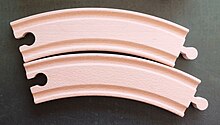Jastrow illusion
The Jastrow Illusion is an optical illusion that was described by the American psychologist Joseph Jastrow in 1892 .
Two circular curved track sections are laid one below the other as in the picture. The lower section appears to be longer, but it is not. This illusion is created by comparing the two track sections in the area where they are close. So you intuitively compare the larger circular arc (below, red) with the smaller one (above, magenta) and feel that the lower track section is longer than the upper one. What is important for this illusion is that the two arcs that are being compared begin at the same point.
The following applies to the length of a circular arc: Length = radius × angle (in radians ). The angles are the same for the red and magenta circular arcs. The red arch has a larger radius than the magenta arch, so it's longer. For non-curved sections, a track section forms a rectangle and the opposite sides are the same length.
literature
- World of Wonders: A Record of Things Wonderful in Nature, Science and Art. Cassel, Petter & Galpin, London et al. 1873, p. 11 .
Web links
Individual evidence
- ^ Joseph Jastrow: Studies from the Laboratory of Experimental Psychology of the University of Wisconsin. II. In: The American Journal of Psychology. Vol. 4, No. 3, 1892, pp. 381-428, doi: 10.2307 / 1411617 .

